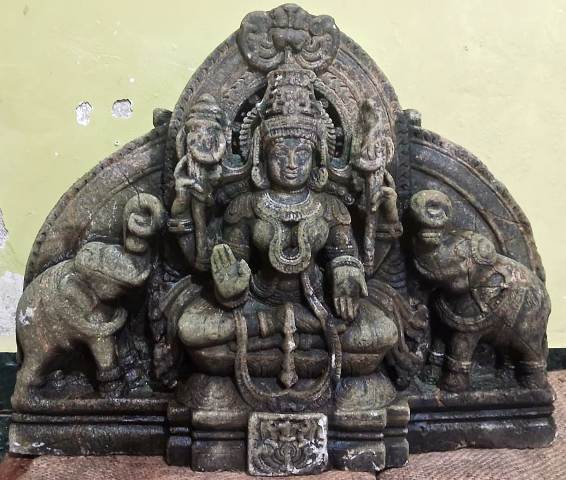Goa: A unique sculpture of Gajalakshmi found accidentally in the Valvanti River at Parye near Sattari Keri, in Sattari Taluk of Goa, which was noticed and preserved by Dr. Rajendra Kerkar, the president o Adima Kala Trust (R.), Udupi and subsequently brought to the notice of Prof. T. Murugeshi founder trustee of the Adima Kala trust (R.), Udupi, says Prof. T. Murugeshi in his press release here today. Gajalakshmi is seated on a lotus pedestal in a calm and divine expression with four hands. Lower right hand in Abhaya and left in Varada mudra and she holds lotus bud in the upper right hand and appear to hold the same lotus bud in the upper left hand. She wears lower garment and Makarakundalas in her ears. She had a very beautiful head gear in the form of three tiered Karanda Mukuta or kirita with a canopy. There is a oval shape Prabhavali with Simha or lion lalata at centre. She was flanked by two elephants with sacred kalasha’s on either side of the image.

A noteworthy feature of the sculpture is representation of Gandaberunda a mythical animal at the centre of the pedestal in a floral form. The image is about 50 cm in length and 61 cm in width.
Historical Importance:
The Gajalakshmi found in Parye is of great historical significance in the history of Goa. This sculpture stylistically belongs to 10th century A.D. and best example of Kadambas of Goa.
In Goa, I noticed number of Gajalaxshmi panals in sacred forests and outside the many temple premises. They represent war scenes and Lakshmi in tribal form. But, the sculpture under study represents the greater tradition of Vaisnava cult. The Gandaberunda was the royal emblem of the Kadambas, Vijayanagar, Wodeyars of Mysore and at presently of the state of Karnataka.
I am thankful to Dr. Rajendra Kerkar and team for their help in studying this wonderful sculpture.
